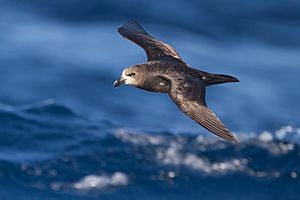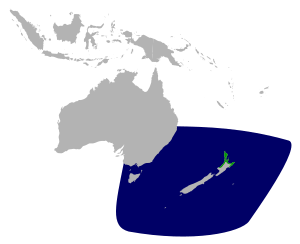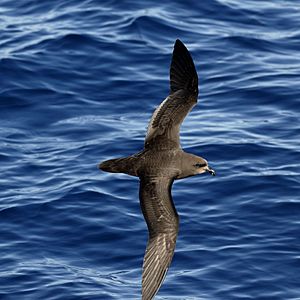Grey-faced petrel facts for kids
Quick facts for kids Grey-faced petrel |
|
|---|---|
 |
|
| East of the Tasman Peninsula, Tasmania, Australia | |
| Conservation status | |
| Scientific classification | |
| Genus: |
Pterodroma
|
| Species: |
gouldi
|
 |
|
| Estimated at-sea distribution Breeding grounds | |
The grey-faced petrel (Pterodroma gouldi) is a type of petrel bird. It lives only in the North Island of New Zealand. In New Zealand, people also call it by its Māori name ōi. Sometimes, it's known as a muttonbird, a name shared with other similar birds.
Contents
About the Grey-faced Petrel's Family Tree
For a long time, the grey-faced petrel was thought to be a smaller group (subspecies) of another bird. This bird was called the great-winged petrel. But in 2014, scientists decided it was different enough. They said it should be its own separate species. More research in 2016 confirmed this idea.
What Does the Grey-faced Petrel Look Like?
Grey-faced petrels are large birds. They are about 42 to 45 centimeters long. On average, they weigh around 550 grams. They have a dark black-brown color. This is similar to the black-footed albatross. Their bill is black. They have pale grey or light brown feathers near their bill and throat.
Their wings are long. These long wings help them fly in a bouncy way. It is easy to confuse grey-faced petrels with Great-winged petrels. This happens where they live in the Tasman Sea. They look very much alike.
Where Do Grey-faced Petrels Live?
The grey-faced petrel only breeds in the northern part of New Zealand's North Island. Most of their breeding groups, called colonies, are on islands off the coast. Some smaller groups still live on the mainland. These birds can breed successfully where harmful animals are controlled. These harmful animals include rats, cats, and stoats.
The biggest breeding colony is on Moutohora Island. About 95,000 pairs of birds breed there. When it's not breeding season, the birds fly over the warm southwest Pacific Ocean. This includes areas near Australia and Norfolk Island. They mostly stay between 25 and 50 degrees south. Sometimes, they might fly into very cold Antarctic waters.
Grey-faced Petrel Behaviour and Life
Reproduction and Life Cycle
The first grey-faced petrels start coming back to their colonies in mid-March. But most birds do not start cleaning their burrows until April. They find a partner from late April to mid-May. Then, the breeding pair leaves for a trip before laying their egg. This trip lasts 50 to 70 days for females. During this time, they form their one large egg.
The first eggs are laid in mid-June. Most eggs are laid in the first 10 days of July. The last eggs are laid in late July. The egg takes about 55 days to hatch. Both parents take turns sitting on the egg. They swap places about every 17 days. Males do two long shifts. Females do one long shift. They usually return close to when the egg hatches.
Chicks are left alone in their burrows during the day. This happens when they are 1 to 3 days old. The parents might fly up to 600 kilometers to find food for their chick. The chick is fed by its parents for about 120 days. Then, it leaves the nest in December or January. After breeding, the adult birds mostly fly to the seas off eastern and southern Australia. There, they change their feathers.
What Do Grey-faced Petrels Eat?
Grey-faced petrels usually hunt for squid, fish, and small sea creatures called crustaceans. Sometimes, they will also eat food they find floating. They mostly hunt at night. Many of the animals they eat glow in the dark. Scientists think the petrels use these light signals to help them hunt.
Threats and Conservation Efforts
Grey-faced petrels have a very large population. They also live over a wide area. Because of this, the IUCN says they are of "least concern." This means they are not currently in danger. Also, in New Zealand, they are listed as "Not Threatened." This is because their numbers are growing.
One of the biggest dangers to grey-faced petrels is at their breeding places. Animals like Norway rats, which were brought to New Zealand, hunt them. Eggs left alone and young or weak chicks are most at risk. This can lower how many chicks survive in the colonies. Also, animals that dig burrows, like rabbits, can bother the petrels. They might even take over their burrows. This can make the birds leave their nests.
However, projects to get rid of these harmful animals have helped. For example, on Moutohora Island, these projects have allowed some colonies to grow. Bright lights from towns can also attract young grey-faced petrels. They might confuse the artificial light with the glowing animals they eat.
How Humans and Grey-faced Petrels Interact
In New Zealand, some Māori iwi (tribes), like Ngāti Awa and the Hauraki iwi, have traditional rights. They are allowed to harvest grey-faced petrel chicks. In the mid-1900s, these iwi put a rahui (a ban) on harvesting. This was because the bird numbers were going down. But now that the populations have recovered, harvesting has started again. Research has been done to find out how many chicks can be harvested safely. This helps make sure the colonies stay healthy.
Images for kids
See also
 In Spanish: Petrel carigrís para niños
In Spanish: Petrel carigrís para niños





